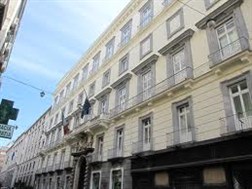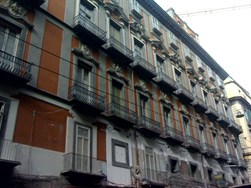Palaces
 During his career, he worked on countless commissions, and not only in Naples, designing sacred buildings, civil and religious, but also on sculptures, street furnishings, interior decorations and altars, the latter characterized by the intense use of geometric inlays and floral polychrome marble. Palazzo Zevallos Stigliano, located in the central Via Toledo, which now houses a bank and a gallery and museum with the same name, was built between 1637 and 1639 under the direction of Cosimo Fanzago. It passed from the ownership by the Zevallos family to the Colonna di Stigliano family and the building has undergone several changes over the centuries, although the handwork of the architect who first designed it is still visible.
During his career, he worked on countless commissions, and not only in Naples, designing sacred buildings, civil and religious, but also on sculptures, street furnishings, interior decorations and altars, the latter characterized by the intense use of geometric inlays and floral polychrome marble. Palazzo Zevallos Stigliano, located in the central Via Toledo, which now houses a bank and a gallery and museum with the same name, was built between 1637 and 1639 under the direction of Cosimo Fanzago. It passed from the ownership by the Zevallos family to the Colonna di Stigliano family and the building has undergone several changes over the centuries, although the handwork of the architect who first designed it is still visible.
 Palazzo Carafa di Maddoloni, which is also located in the central area of Naples, underwent a deep phase of renovations and modifications in 1656 at the behest of the Duke of Maddaloni Diomede V Carafa. Fanzago’s plans were completed only after the architect’s death, providing, among other things, the portico in front of the entrance and the portal, the expansion of the main staircase and the transformation of the windows in balconies. The property is currently undergoing massive restoration, both internally and externally.
Palazzo Carafa di Maddoloni, which is also located in the central area of Naples, underwent a deep phase of renovations and modifications in 1656 at the behest of the Duke of Maddaloni Diomede V Carafa. Fanzago’s plans were completed only after the architect’s death, providing, among other things, the portico in front of the entrance and the portal, the expansion of the main staircase and the transformation of the windows in balconies. The property is currently undergoing massive restoration, both internally and externally.
 The works for the construction of Palazzo Donn’Anna, located in Via Posilippo, began in 1642 at the behest of Anna CarafaAnna Carafa della Stadera (1607-1644), the Princess of Stigliano, was the only daughter of Antonio Carafa della Stadera, the Duke of Mondragone, and Elena Aldobrandini, nephew of Pope Clement VIII. She married the Duke of Medina de las Torres Ramiro Núñez de Guzmán, viceroy of Naples from 1637 to 1644, inheriting the Duchy of Sabbioneta from her paternal grandmother Anna Isabella Gonzaga. At her death, in 1644, the duchy passed to Scipione Gonzaga, the first prince of Sabbioneta., the wife of the viceroy Ramiro Núñez de Guzmán, Duke of Medina de las Torres. The project, which began with the demolition of an old building, involved the construction of a luxury residence with direct access, by land and by sea, with magnificent apartments and a façade full of niches and large windows. The base of the building is in tuff and rests directly on the rock of the cliff. Anna Carafa’s death, in 1645, prevented Fanzago from completing the work, giving a romantic aspect to the building, however, halfway between the ruins and the rocky promontory, which adds to its charm and beauty.
The works for the construction of Palazzo Donn’Anna, located in Via Posilippo, began in 1642 at the behest of Anna CarafaAnna Carafa della Stadera (1607-1644), the Princess of Stigliano, was the only daughter of Antonio Carafa della Stadera, the Duke of Mondragone, and Elena Aldobrandini, nephew of Pope Clement VIII. She married the Duke of Medina de las Torres Ramiro Núñez de Guzmán, viceroy of Naples from 1637 to 1644, inheriting the Duchy of Sabbioneta from her paternal grandmother Anna Isabella Gonzaga. At her death, in 1644, the duchy passed to Scipione Gonzaga, the first prince of Sabbioneta., the wife of the viceroy Ramiro Núñez de Guzmán, Duke of Medina de las Torres. The project, which began with the demolition of an old building, involved the construction of a luxury residence with direct access, by land and by sea, with magnificent apartments and a façade full of niches and large windows. The base of the building is in tuff and rests directly on the rock of the cliff. Anna Carafa’s death, in 1645, prevented Fanzago from completing the work, giving a romantic aspect to the building, however, halfway between the ruins and the rocky promontory, which adds to its charm and beauty.
